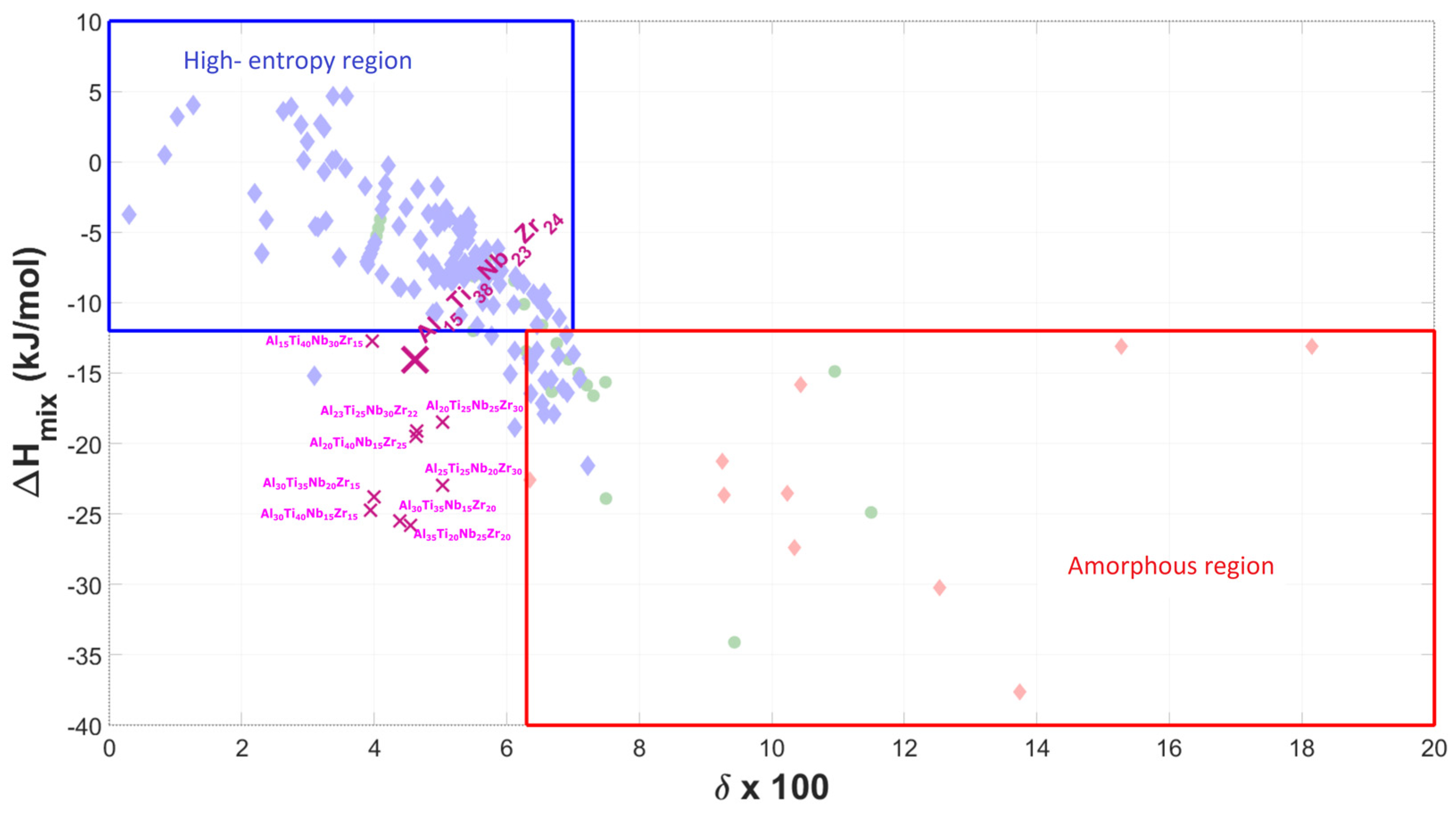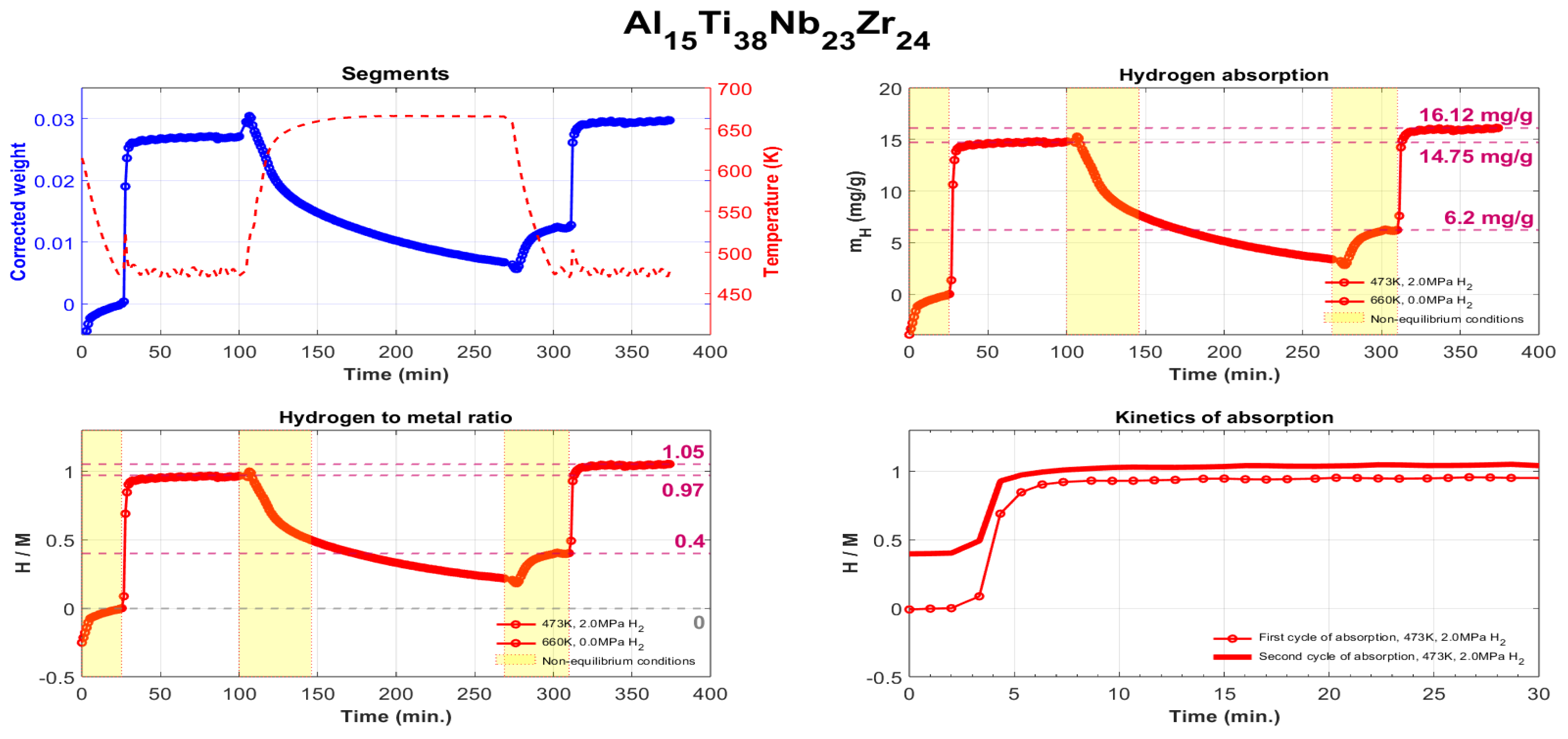Research and Development of New High-Entropy Alloys for Hydrogen Storage †
Abstract
1. Introduction
2. Materials and Methods
3. Results
4. Conclusions
Author Contributions
Funding
Institutional Review Board Statement
Informed Consent Statement
Data Availability Statement
Conflicts of Interest
References
- Annual Activity Report 2020. 2020. Available online: https://www.clean-hydrogen.europa.eu/system/files/2021-06/FCH-20-001-Annual%2520report%25202020%2520%2528ID%252011531857%2529.pdf (accessed on 8 February 2024).
- IEA. World Energy Model; IEA: Paris, France, 2021. Available online: https://www.iea.org/reports/world-energy-model (accessed on 8 February 2024).
- Züttel, A. Materials for hydrogen storage. Mater. Today 2003, 6, 24–33. [Google Scholar] [CrossRef]
- Murty, B.S.; Yeh, J.W.; Ranganathan, S.; Bhattacharjee, P.P. High-Entropy Alloys, 1st ed.; Elsevier: Amsterdam, The Netherlands, 2014. [Google Scholar]
- Guo, S.; Liu, C.T. Phase stability in high entropy alloys: Formation of solid-solution phase or amorphous phase. Prog. Nat. Sci. Mater. Int. 2011, 21, 433–446. [Google Scholar] [CrossRef]
- MATLAB—MathWorks. IsoSORP. Available online: https://www.mathworks.com/products/matlab.html (accessed on 21 April 2023).
- Joubert, J.M.; Paul-Boncour, V.; Cuevas, F.; Zhang, J.; Latroche, M. LaNi5 related AB5 compounds: Structure, properties and applications. J. Alloys Compd. 2021, 862, 158163. [Google Scholar] [CrossRef]
- Joubert, J.M.; Paul-Boncour, V.; Cuevas, F.J. Sorption Analysis under Extreme Conditions—TA Instruments. Available online: https://www.tainstruments.com/isosorp/ (accessed on 21 April 2023).



| Alloy | ΔHmix [kJ/mol] | δ× 100 | ΔSmix | VEC |
|---|---|---|---|---|
| Al30Ti35Nb15Zr20 | −25.50 | 4.39 | 11.10 | 3.85 |
| Al23Ti25Nb30Zr22 | −19.11 | 4.64 | 11.46 | 4.07 |
| Al30Ti35Nb20Zr15 | −23.80 | 3.99 | 11.10 | 3.90 |
| Al25Ti25Nb20Zr30 | −22.94 | 5.03 | 11.44 | 3.95 |
| Al15Ti38Nb23Zr24 | −14.08 | 4.61 | 11.08 | 4.08 |
| Al35Ti20Nb25Zr20 | −25.82 | 4.54 | 11.29 | 3.90 |
| Al30Ti40Nb15Zr15 | −24.72 | 3.95 | 10.78 | 3.85 |
| Al20Ti25Nb25Zr30 | −18.46 | 5.04 | 11.44 | 4.05 |
| Al20Ti40Nb15Zr25 | −19.48 | 4.62 | 10.97 | 3.95 |
| Al15Ti40Nb30Zr15 | −12.72 | 3.96 | 10.78 | 4.15 |
| Alloy | EDX | Microhardness [HV0.3] | Density [g.cm−3] |
|---|---|---|---|
| Al30Ti35Nb15Zr20 | Al30Ti34Nb14Zr22 | 532 ± 93.41 | 5.311 ± 0.009 |
| Al23Ti25Nb30Zr22 | Al23Ti27Nb28Zr22 | 453 ± 43.79 | 6.011 ± 0.006 |
| Al30Ti35Nb20Zr15 | Al31Ti36Nb20Zr13 | 542 ± 20.81 | 5.52 ± 0.14 |
| Al25Ti25Nb20Zr30 | Al24Ti26Nb21Zr30 | 444 ± 7.04 | 5.83 ± 0.02 |
| Al15Ti38Nb23Zr24 | Al16Ti38Nb23Zr23 | 376 ± 9.039 | 5.87 ± 0.012 |
| Al35Ti20Nb25Zr20 | Al33Ti23Nb24 Zr20 | 747 ± 31.15 | 5.811 ± 0.008 |
| Al30Ti40Nb15Zr15 | Al28Ti38Nb16Zr18 | 587 ± 18.5 | 5.461 ± 0.017 |
| Al20Ti25Nb25Zr30 | Al21Ti26Nb26Zr27 | 470 ± 141.3 | 6.151 ± 0.019 |
| Al20Ti40Nb15Zr25 | Al19Ti41Nb15Zr25 | 353 ± 10.6 | 5.641 ± 0.004 |
| Al15Ti40Nb30Zr15 | Al14Ti39Nb29 Zr18 | 398 ± 20.9 | 6.11 ± 0.02 |
| Alloy | Absorption H [wt.%/H/M] | Residual H [wt.%/H/M] | Desorption H [wt.%/H/M] | Cycle Efficiency [%] |
|---|---|---|---|---|
| Al30Ti35Nb15Zr20 | 1.28/0.74 | 0.46/0.26 | 0.82/0.48 | 64.86 |
| Al23Ti25Nb30Zr22 | 1.06/0.69 | 0.25/0.16 | 0.81/0.53 | 76.81 |
| Al30Ti35Nb20Zr15 | 0.98/0.54 | 0.27/0.15 | 0.71/0.39 | 72.22 |
| Al25Ti25Nb20Zr30 | 1.23/0.82 | 0.41/0.27 | 0.82/0.55 | 67.07 |
| Al15Ti38Nb23Zr24 | 1.61/1.05 | 0.62/0.40 | 0.99/0.65 | 61.90 |
| Al35Ti20Nb25Zr20 | 0.79/0.48 | 0.18/0.10 | 0.61/0.38 | 79.16 |
| Al30Ti40Nb15Zr15 | 1.10/0.63 | 0.37/0.22 | 0.73/0.41 | 65.08 |
| Al20Ti25Nb25Zr30 | 1.28/0.86 | 0.43/0.29 | 0.85/0.57 | 66.28 |
| Al20Ti40Nb15Zr25 | 1.28/0.79 | 0.54/0.33 | 0.74/0.46 | 58.23 |
| Al15Ti40Nb30Zr15 | 1.33/0.88 | 0.30/0.20 | 1.03/0.68 | 77.27 |
Disclaimer/Publisher’s Note: The statements, opinions and data contained in all publications are solely those of the individual author(s) and contributor(s) and not of MDPI and/or the editor(s). MDPI and/or the editor(s) disclaim responsibility for any injury to people or property resulting from any ideas, methods, instructions or products referred to in the content. |
© 2024 by the authors. Licensee MDPI, Basel, Switzerland. This article is an open access article distributed under the terms and conditions of the Creative Commons Attribution (CC BY) license (https://creativecommons.org/licenses/by/4.0/).
Share and Cite
Varcholová, D.; Oroszová, L.; Kušnírová, K.; Saksl, K. Research and Development of New High-Entropy Alloys for Hydrogen Storage. Eng. Proc. 2024, 64, 9. https://doi.org/10.3390/engproc2024064009
Varcholová D, Oroszová L, Kušnírová K, Saksl K. Research and Development of New High-Entropy Alloys for Hydrogen Storage. Engineering Proceedings. 2024; 64(1):9. https://doi.org/10.3390/engproc2024064009
Chicago/Turabian StyleVarcholová, Dagmara, Lenka Oroszová, Katarína Kušnírová, and Karel Saksl. 2024. "Research and Development of New High-Entropy Alloys for Hydrogen Storage" Engineering Proceedings 64, no. 1: 9. https://doi.org/10.3390/engproc2024064009
APA StyleVarcholová, D., Oroszová, L., Kušnírová, K., & Saksl, K. (2024). Research and Development of New High-Entropy Alloys for Hydrogen Storage. Engineering Proceedings, 64(1), 9. https://doi.org/10.3390/engproc2024064009






